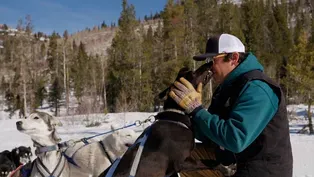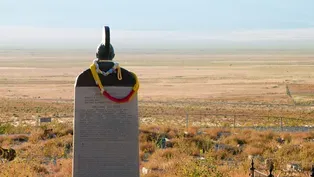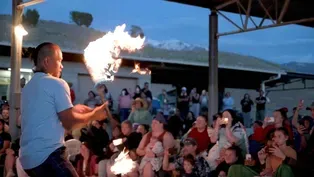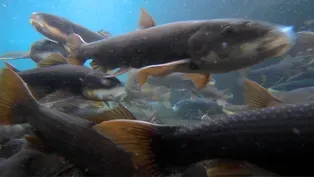
Sanctuary
Season 5 Episode 1 | 26m 34sVideo has Closed Captions
Discover a connection between people, animals, and sanctuary in three compelling stories.
Journey through the landscapes of Utah, discovering the heartwarming story of Luna Lobos, a sanctuary where dogs and humans find healing. Dive into the importance of restoring habitats for endangered species, with a focus on the native June sucker fish. Lastly, explore the little-known history of Polynesian settlers in Utah and witness how their legacy is being preserved today.
This Is Utah is a local public television program presented by PBS Utah
Funding for This Is Utah is provided by the Willard L. Eccles Foundation and the Lawrence T. & Janet T. Dee Foundation, and the contributing members of PBS Utah.

Sanctuary
Season 5 Episode 1 | 26m 34sVideo has Closed Captions
Journey through the landscapes of Utah, discovering the heartwarming story of Luna Lobos, a sanctuary where dogs and humans find healing. Dive into the importance of restoring habitats for endangered species, with a focus on the native June sucker fish. Lastly, explore the little-known history of Polynesian settlers in Utah and witness how their legacy is being preserved today.
How to Watch This Is Utah
This Is Utah is available to stream on pbs.org and the free PBS App, available on iPhone, Apple TV, Android TV, Android smartphones, Amazon Fire TV, Amazon Fire Tablet, Roku, Samsung Smart TV, and Vizio.
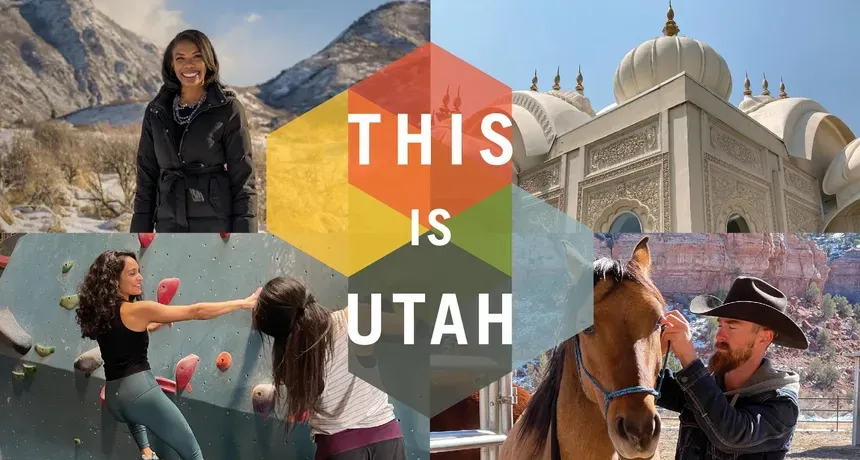
This is Utah
Liz Adeola travels across the state discovering new and unique experiences, landmarks, cultures, and people. We are traveling around the state to tell YOUR stories. Who knows, we might be in your community next!Providing Support for PBS.org
Learn Moreabout PBS online sponsorship(Gentle Music) Well, welcome to the beauty and serenity that is Red Butte Gardens As we launch into another episode of This is Utah.
I'm your host, Liz Adeola, and I want to know what space holds the power of sanctuary for you?
In this episode, we explore one sanctuary where competition on the snow coincides with therapy for rescue dogs and their two-legged friends.
Dive from fur to fins in another race.
The race to restore the Provo River Delta for a species of fish native to Utah.
And learn how this area of land helped people reclaim a sense of home in Utah in an effort that began more than a century ago.
This is Utah is made possible in part by the Willard L. Eccles Foundation.
The Lawrence T. and Janet T. Dee Foundation.
And by the contributions to PBS Utah from viewers like you.
Thank you!
(Upbeat Music) Luna Lobos is a dog sanctuary in Utah where second chances reign supreme.
It's a place where children learn valuable lessons alongside rescue dogs as they forge their paths in life.
(gentle music) - So it started out when I was a little boy.
I had just seen the movie "Balto".
Now, my little brothers, and they had this little plastic toy table, so I turned it upside down and attached skis to it, and I had my yellow lab pull me around my parents' property.
They thought it was funny, and ironically, they were out in a garage sale around Park City and they saw an old dog sled.
Now, the only requirement that my mom had was that she says, you know, "We'll go along with this journey, but we have to rescue the dogs from shelters.
We're gonna build your team from scratch."
With sled dogs, it was always the idea of like, I wanna be a champion.
If I can be an Iditarod champion, gosh, that'd be amazing.
And so I had always grew with the mentality that if I'm a champion, then I'm worth something.
(gentle music continues) Rancho Luna Lobos is a 55 acre ranch specializing in northern breeds.
So, we are a rescue rehabilitation center, and we use dog sledding as a form of therapy for these guys.
(dogs barking) Uba.
Dana and I are typically up around 6:30, getting the day started.
(dogs barking) Good morning!
Mr. Peroda.
When you're working with a kennel of 80 plus dogs, you have to take in consideration that, you know, you're thinking not of yourself, but of other living beings.
So, you know, Dana and I, we have our family of our kids, and not only do we have to be parents to them, but I feel like we have to, in a sense, be parents to the dogs.
- No, come on.
It's provided such a unique teaching opportunity for our kids to really learn how to have a servant's heart and a servant's mind, and that's something that we're so passionate about.
You really have to feel what the dogs are saying and work in a way where you are showing them love and patience with your actions.
And that is an easier concept for kids to understand when they're working with the dogs.
- Just use the shovel and then attack the runway, okay?
I got most of it, but start from the top gate and just work your way down and just...
Okay, baby?
It's funny, most kids have their chores to do while they clean their rooms, and these guys have to do dog chores if they wanna race in season, so.
This is the majority of our group here, and they're a mixture of race dogs or really high strung touring dogs.
And so they get along well, they're on the same vibe, the same frequency, they play hard together.
And then I have the evening crew that are more mellow, a little more reserved, that are normally too shy to run around with these guys.
And so they come out during evening play time.
And then I have those that I'm still working with that maybe have a little bit of a, we call a trigger or red flag.
They may flip on a dime and they may cause, like, an altercation.
We'll take a group of five or six of 'em and do a free hike.
They kind of get their stimulation, we can still work with them, and then slowly ease 'em into one of the playgroups.
Hey Sarah, can you let out Frida please?
(Frida barking) When Frida's mom called us asking if we had any room for her, Frida was found wandering a parking lot.
They picked her up, they took her home to their apartment, but they knew that they couldn't keep her, so when they dropped her off at the ranch, they didn't really know her history too well, but they knew that she didn't get along very well with other dogs.
So, that right there was our initial like, okay, that's our project, that's our work.
- We always say that we are not dog whisperers.
We aren't going around saying, "I want you to sit, stay, shake.
I want you to do this and that."
Instead, we believe in being dog listeners, because our dogs have a voice, they have a purpose, and it's our responsibility to really listen and learn what it is that they wanna teach us through their journeys.
Are they gonna love being a sled dog or would they love being a ranch dog, which is great too?
Or would they thrive in a family?
Awesome, we'll help 'em find the right family.
We just want them to find their perfect life, their best life.
So welcome to the ranch.
This here is our doggy pueblo area, so this is a multi-use spot.
My name is Dana.
My husband Fernando is running summer camp, we'll run into him at some point today.
So our summer camp is designed to really help kids to unplug from technology and get back to basics, get involved in nature, get outside of themselves for a minute, and we use our dogs, their stories, to really develop that with these kids.
- My favorite story to tell is the story of Maya.
She didn't look anything like a sled dog, you know fluffy Siberian Husky or Alaskan Malamute, but it was what was in her heart that mattered most.
I always turn it around on the kids, and like, how many of us have overlooked other kids because of their outward appearance and not giving them a chance?
She didn't look like she was a champion.
She was the only one, the only dog in our kennel that was a champion.
I want you to think of that.
The smallest but mightiest dog that didn't look anything like a Husky was the only dog that was a champion.
(children chattering) - I learned that it's hard to do stuff together.
Like, some people are pushing it a little left or right.
It's really important for teamwork because if you don't, you can, like, fall or you can be unbalanced.
But it's just fun to see how it works.
I love dogs.
I actually have two of my own.
They're quite hard to take care of.
I can't even believe how they rescue all of these because there's 85 dogs.
They probably have to train them again, and like, they might be scared of people.
There's a lot of dogs that are very, very shy.
(children chattering) - Let's go, Frida.
(gentle music) - We get the dogs that no one else wants.
They've bitten people, they've attacked other dogs, and so no one wants anything to do with 'em.
And it's tough.
And it's also tough when we get dogs that have come from such a loving home and they don't have that family anymore.
- Dog sledding provides such a powerful outlet for dogs.
And a lot of people say, "Well, you're never gonna be competitive if you don't start having these proven bloodlines."
But I've seen our rescues be just as competitive and just as passionate and they have more heart than any other dog out there.
- Does dog sledding need to exist now?
No, it doesn't.
But I do think in a spiritual aspect and a more therapeutic aspect, I think it's still much needed, you know, for both people and dogs.
When you have it all together and it was working well, it's a work of art.
It's funny how it went from wanting to really have a fast team and to win races and wow, that's great, and what gets me now is that my dream lies within the ranch and changing lives.
Inspiring kids and adults that come and they wanna learn about the dogs, and spreading hope.
That's my dream.
Dana and I took it upon ourselves to really build the foundations of what would become Luna Lobos, and with our children being so young, it was tough at first, but they were always so a part of the dog world and a part of everything.
And I would love for one day if one of the children would wanna take over this, and not necessarily the touring aspect, but take over the sanctuary and take over the ranch, the therapy that we work so hard in.
We feel like it's our job to save as many lives as we can.
We can't take 'em all, we can't save 'em all, but the ones that we do take in, I know that will make a difference in their life.
And if it makes a difference in that one dog's life, you know, that's all we can ask for, giving them a safe sanctuary to thrive in.
- Out here on the water, you can almost feel a certain sense of harmony and balance.
But below the surface of some Utah rivers and lakes, an imbalance has nearly wiped out native species of fish.
Now a plan to save the June sucker fish is giving new hope to other species that are in danger.
(soft upbeat music) - The June sucker is a real unique fish.
Lives in Utah Lake naturally, and that's the only place it lives in the world.
They get the name June sucker because they typically spawn in the spring, they drift down the river into suitable habitat where they can grow and avoid predators.
June sucker rely on the Utah Lake ecosystem for their survival, and if the ecosystem's not doing well, neither are the species that occur there.
The June sucker was thought to be extinct.
Some biologists with the Division of Wildlife back in the 70s found a few remaining suckers moving up the Provo River to spawn in the spring.
Soon after that, in 1986, June sucker were listed as endangered, and it was estimated that there were fewer than 1,000 individuals left in the population.
- Where we are standing right now is on the shoreline of Utah Lake.
We are just west of the lowered portion of what's been known as Skipper Bay dike which is a that was started in different phases, dating back almost 100 years.
All of this area, for about seven miles of this shoreline was the geologically historic delta of all the sediment that Provo Rivers brought down from the Winter Mountains through Provo Canyon and created this feature that kind of protrudes out into Utah Lake.
(bright upbeat music) - The Utah Lake ecosystem has been in trouble for a long time.
Utah Lake is of course surrounded by urbanization.
There's been a lot of non-native fish introduced into the system which impact the native species.
So just a number of changes brought on by us that have altered the ecosystem to the point where some of the native species haven't been doing so well.
And June sucker being our target species that we're trying to recover.
- The Delta Restoration Project is a very large scale, ambitious and collaborative restoration effort.
We purchased about 260 acres of property here and we'll be diverting the majority of Provo River's flow out into this area where we've, since almost three years now, we've been digging and excavating ponds and delta habitats and essentially bringing the river to the lake and the lake back to the river.
- As the river slows down and hits flat ground, naturally, it'll spread out and form these fingers.
And then there'll also be wetlands associated with that and side water.
So it really makes a complex aquatic habitat.
These young fish can seek out cover to hide from predators and we're raising fish in the hatchery, stocking them back out into the lake.
And today we have a spawning population, somewhere between 30,000 and 50,000 fish.
We knew if we didn't protect these species in captivity, that we were gonna lose them in the natural system.
- Right here, we're looking at kind of this remaining glass sliver of what used to be a levee on the north side of this downstream most stretch of Provo River.
(audience applauding) And they're gonna pull that last barrier out and allowing the river's flow to enter this community-restored river channel and delta complex and reconnect Provo River with Utah Lake for the first time in like 50 years.
(bright upbeat music) - I was wishing I could have been driving the heavy equipment there but it was awesome to see.
And I mean, look at the river.
I mean, it it looks amazing.
(bright upbeat music) (bright upbeat music) - As the sun rises above Skull Valley, we are shining a light on a piece of unique history about this land.
It's a place that beckoned Hawaiian pioneers more than 130 years ago, eventually paving the way for a community now growing faster than the State of Utah.
(lively Hawaiian drumming) (people clamoring) - To all outsiders, this is a ghost town.
That's why native Hawaiians have to tell this story.
I feel connected to this place because my people came here, they blessed this land with their care-taking.
My name is Kamaile Tripp-Harris, and this is a gathering place for my people.
(lively Hawaiian drumming continues) This is a Memorial weekend celebration that the Iosepa Historical Society puts on every year, and we have a camp out and there's a community lu'au.
Those things that we had established back home in Hawaii were reestablished.
The lu'au was what took place to reunite us and bring us back together, so that's why we do it here at Iosepa.
Iosepa means Joseph in Hawaiian and a lot of people think that it was named after the prophet Joseph Smith, but it wasn't.
It was named after his nephew, Joseph F. Smith, because he served a mission in Hawaii.
When Joseph F. Smith was 15, he, being an orphan, he was sent on a mission by the Church to Hawaii and while he was there, he got really sick, and a woman by the name of Manuhi'i nursed him back to life.
Their relationship would be the strong foundation that brought our people out here, and the reason that they came to this land.
(slow guitar music) (slow guitar music) (slow guitar music) - People wanna come.
They're drawn here, I think, being Hawaiian.
It's a source of real pride.
Humble pride though, ha'aha'a, is what we call it.
You always love where your people are, no matter where they are.
This is John Kauleinamoku.
He was one of the three Hawaiians on the committee that chose Iosepa for the people to live at.
And they loved this place because there was already a ranch, and there were some houses already there, and there was room for them to build more houses.
Our people back home are ranchers and farmers.
- [Kamaile] They knew what they were looking for.
They were looking for mountains that bear snow, 'cause they understand ecosystems and that that land would be their spring water, because these are all the things from our Native Hawaiian agricultural systems.
That's the knowledge they would've brought to Utah.
- And this is what President Hinckley said.
"This was not the desert we see today.
"This was once a beautiful community "and a part of a large mosaic of communities "that our people established all over the West, "and among them stood Iosepa as a gem, a paradise "brought from the islands of the Pacific "to the deserts of the West."
So, that was important to me to know, because everybody says they bought that land and just threw 'em out there.
I'm an amateur researcher, but when you love something so much, you just keep going.
You don't know how to do it, you don't know what you're doing, but you just keep collecting and collecting and somewhere, somebody's gonna say, "Let me tell you how to do this."
(gentle music continues) - Everybody finds their way to Iosepa in different ways and they feel inspired to come back here and then they keep coming back 'cause they feel a profound connection to it.
Spending time with Auntie Charmagne, you can't help but take on some of that responsibility, especially as a Hawaiian.
We call it kuleana.
It means responsibility, but also destiny.
Auntie's work here in the community has been so profound.
She wants us to know not just our language and symbols of our culture, but the deep meaning of it and how it connects us to our past and our future.
It's still a place where our people are and can be and provide that generational education and wealth for everyone.
Let's take a look.
(gentle guitar music) (gentle guitar music) Hannah Kaaepa, in 1899, speech to National Council of Women Iosepa resident urged support of women's voting rights efforts in the Territory of Hawai'i.
- We welcome all of our guests to Iosepa on this momentous occasion to honor our beloved kupuna Hannah Kaaepa.
We welcome the descendants who are led here by a special spirit whose kupuna lie in this sacred (speaks Hawaiian word), and once you come, you will never forget that spirit and you will seek it daily in your life.
Coming here makes you proud because you have this legacy, but to have have us reminded from time to time that we weren't just out here, we were out here doing something.
(gentle guitar music) - So this is the Salt Lake Herald from 1899.
You can see it gives a summary of Hannah Kaaepa's presentation in Washington DC.
- "One of the most interesting events "during the meeting of the National Council of Women "was the presentation to the Council of Hannah Kaaepa, "the young Hawaiian lady "who came here with the Utah delegation.
"She made a few remarks urging support "of ex-Queen Lili'uokalani "in her efforts to go to secure the ballot "for the women of Hawaii."
- Yeah, and Hawaii is just barely becoming a territory under the new government, and then they're fighting for women's rights to vote.
That's so cool!
- We had our first child here in Utah.
My mother flew over to help and then one of the first things she said to us is, "I want to go to Iosepa."
I went, "We don't know where that is."
So we had to drive up and down that Dugway Road.
And so we went in.
Hannah's mom, Makanoe, she's buried out there.
And so we thought, "Wow, we have pioneers here in Utah."
- When Hannah went to Washington, she fought for the rights of not only women to vote, but Native Hawaiian people.
The Native Hawaiian people who lived in the United States didn't have any voting rights and they weren't considered citizens of this country.
I think of Auntie Noe and Auntie Charmagne's success when I see this plaque.
("Nani Na Pua" by Queen Lili'uokalani) (Charmagne speaks in Hawaiian language) - The faithful women of Iosepa.
Yeah, that's our theme this year, because of Hannah.
It's time for people to know, because we were really, were a matriarchal society.
We thought our women were pretty cool.
I still do.
(Charmagne laughs) ("Nani Na Pua" by Queen Lili'uokalani) - You'll find when you search the internet that they say that Hawaiians abandoned Iosepa, but they didn't.
They really wanted to stay.
The generations had gone by long enough that the people who lived here were born here.
So Joseph F. Smith, when he gets sick and is dying, he wants to prepare the people for the coming future.
He tells them, "I won't be here."
He basically says, "I won't be here to advocate for you anymore."
- [Charmagne] And what he said, too, was, "When I'm gone, "they're not going to love you the way that I love you, "and I want to make sure that you're okay "and so I want you to go home."
- [Kamaile] They would've stayed here if they had the opportunity to, but the Church was selling the land and they were building a new temple so that they could go home to Hawaii and do the temple ordinances that they wanted to do here, now, in Hawaii.
- [Charmagne] Even so, it was with reluctance that they abandoned their beloved town.
Rosenberg quoted Alf Callister, a 12-year-old at the time as saying that "When the wagons were loaded to take the settlers away, "the women refused to ride.
"Instead, they walked the distance to the railroad station "and with big tears running down their faces, "kept looking back at their home "and uttering 'Goodbye, Iosepa, goodbye, Iosepa.'"
- Everything that the Native Hawaiian people had done from leaving Hawaii, trusting Joseph F. Smith, coming to Skull Valley where it got colder than a lot of these Hawaiian people ever experienced in their lives, it was all done on faith and ushering a better future for themselves and their family.
When we were here in May, there it was standing room only, almost.
It was so crowded.
It's because there were, literally, four or five generations of families here.
The descendants of Iosepa have continued to take care of the land and share its history with us.
I think a lot of us believe that we don't have pioneer ancestral roots because we're not descendants of those European ones.
But yeah, you have to come out to Iosepa (Kamaile chuckles) and you'll see that we were pioneers in our own right.
(energetic drumming) (people vocalizing jubilantly) (energetic drumming) So where's your sanctuary?
I want to hear all about it on This is Utah's YouTube, Facebook and Instagram pages.
Leave a comment.
Hit the like button, and share your favorite stories.
And don't forget to subscribe as well.
Until next time.
I'm Liz Adeola, and This is Utah This is Utah is made possible in part by the Willard L. Eccles Foundation.
The Lawrence T. and Janet T. Dee Foundation.
And by the contributions to PBS Utah from viewers like you.
Thank you!
(Upbeat Music)
Video has Closed Captions
A safe haven for humans and dogs, transforming lives and creating lasting connections. (9m 5s)
Video has Closed Captions
Discover a former settlement of Polynesian pioneers, a memorial and gathering place. (11m 15s)
Discover a connection between people, animals, and sanctuary in three compelling stories. (30s)
Video has Closed Captions
Rescuing the June sucker fish brings hope for the future of Utah's aquatic ecosystems. (5m 4s)
Providing Support for PBS.org
Learn Moreabout PBS online sponsorshipThis Is Utah is a local public television program presented by PBS Utah
Funding for This Is Utah is provided by the Willard L. Eccles Foundation and the Lawrence T. & Janet T. Dee Foundation, and the contributing members of PBS Utah.


